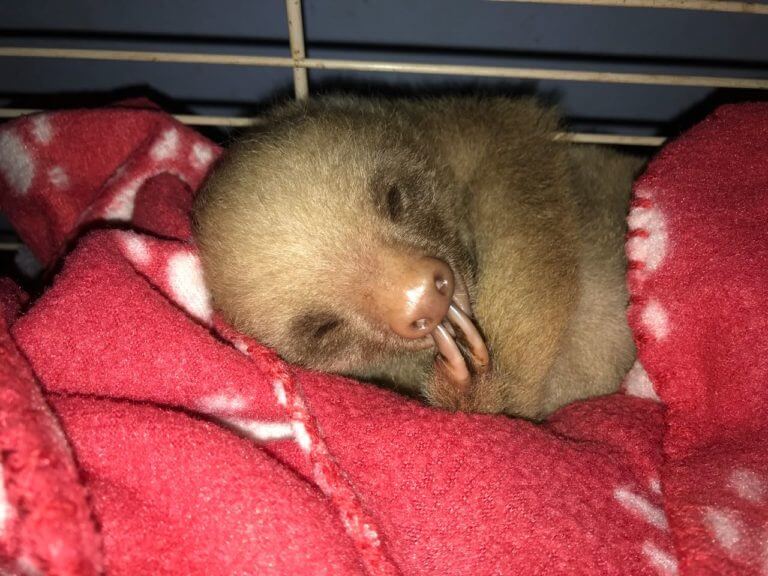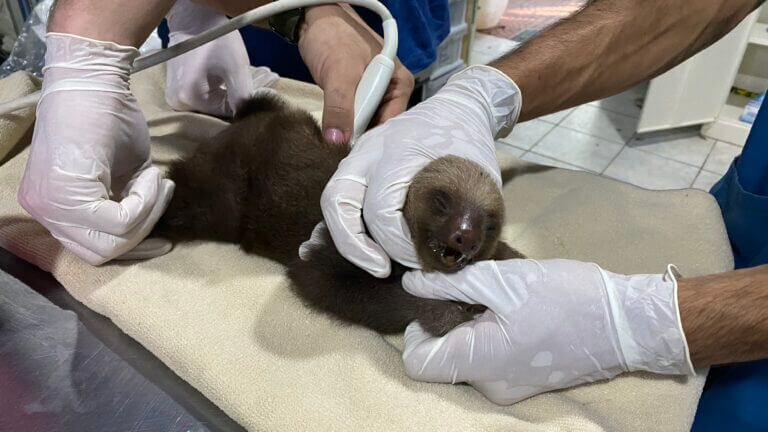Three-toed Sloths and Two-toed Sloths: Characteristics, Distribution, and Threats
Scientific name of three-toed sloth: Bradypus variegatus.
Scientific name of two-toed sloth: Choloepus hoffmani.
Distribution: From Honduras to northern Argentina and Peru.
Three-toed Sloths and Two-toed Sloths are fascinating mammals that inhabit from Honduras to northern Argentina and Peru. In this article, we will explore their scientific names, geographical distribution, and the importance of their conservation.
Sloths, descendants of Megatherium, are animals known for their cute appearance and their habitat in the tropical forest. However, few are aware of the threats they face due to deforestation, hunting, and illegal wildlife trafficking. Throughout evolutionary history, these mammals have adapted their size and arboreal habits. Currently, there are six species of sloths found in Central and South America.
Evolutionary History of Three-toed Sloths and Two-toed Sloths
Sloths descend from Megatherium, a giant mammal that lived from the Pliocene to the early Heliocene. Although prehistoric sloths were large, they have reduced in size and adopted arboreal habits. The giant sloth fed on fruits and leaves, playing a crucial role in the dispersal of avocado seeds of that time.
Distribution and Habitat
Sloths are found in the tropical forests of Central and South America. Their camouflage abilities make them difficult to detect. Sometimes, they can be found in urban areas, crossing roads in search of suitable habitat. Animal bridges can offer a solution to protect them from road dangers.
Behavior and Characteristics
Sloths are slow-moving animals due to their slow digestion process. Both three-toed and two-toed sloths can be either diurnal or nocturnal. They hang from branches and only descend from trees to defecate once a week. Although they are not typically aggressive, they can use their claws as defensive weapons.
Conservation and Threats of the Three-toed Sloths and Two-toed Sloths
While sloths are not currently endangered, they face threats such as deforestation, hunting, and illegal wildlife trade. Raising awareness about the importance of protecting their habitat and avoiding their capture as pets is crucial. Various organizations and wildlife sanctuaries work towards their conservation.
Importance of Conservation
Sloths play a vital role in the ecosystems of tropical forests. They contribute to seed dispersal and maintain vegetation balance. By adopting a conservation approach, we can ensure the survival of these species and preserve the biodiversity of our ecosystems.
Fascinating Facts About Sloths
Here are seven curious facts about the two species of sloths that exist in Costa Rica:
1. Bradypus variegatus, the three-toed sloth, can move so slowly that algae can grow on its fur, providing them with natural camouflage in the trees.
2. Choloepus hoffmani, the two-toed sloth, has the unique feature of having more neck vertebrae than any other mammal, allowing it to rotate its head up to 270 degrees.
3. Sloths have a low metabolic rate, which means their digestion is extremely slow. It can take them up to a month to digest a single leaf.
4. Although sloths are known for their slow movement, they are actually excellent swimmers and can cross rivers and streams with ease.
5. These adorable mammals spend most of their lives in trees and rarely descend to the ground. In fact, it is believed that they only come down to the ground once a week to defecate.
6. Sloths have long, curved claws that allow them to firmly grip tree branches. These claws are also used as defensive weapons in case of an attack.
7. Despite their peaceful appearance, male sloths can be quite territorial. They use vocalizations and tree scratches to communicate and establish their dominance over a specific area.
These interesting facts highlight some of the fascinating characteristics and behaviors of three-toed and two-toed sloths inhabiting Costa Rica.
Three-Toed and Two-Toed Sloths in Costa Rica
Three-toed sloths (Bradypus variegatus) and two-toed sloths (Choloepus hoffmanni) are two species of mammals that have a prominent presence in Costa Rica. This beautiful country, known for its incredible biodiversity, harbors these adorable creatures in its lush tropical jungles.
Costa Rica provides an ideal home for sloths, as its dense and leafy forests offer the perfect habitat for leading a tranquil arboreal life.
Where to Find Sloths in Costa Rica?
These animals can be found in various locations across the country, including national parks such as Manuel Antonio National Park, Corcovado National Park, and Monteverde Biological Reserve.
Conservation of three-toed and two-toed sloths in Costa Rica is of utmost importance. These species play a crucial role in ecosystems by contributing to seed dispersal and maintaining vegetation balance. Additionally, their presence is a tourist attraction for visitors who want to observe and learn about these charming creatures.
However, sloths also face threats in their natural habitat. Deforestation, habitat fragmentation, and illegal hunting are some of the challenges they encounter in Costa Rica.
It is essential to raise awareness about the importance of protecting these animals and their environment, as well as to support conservation initiatives and educational programs.
Organizations Protecting and Rescuing Sloths in Costa Rica
Natuwa is a prominent organization in Costa Rica dedicated to the protection and conservation of sloths. They play a vital role in safeguarding these unique creatures through various initiatives. Natuwa focuses on raising awareness about sloth conservation, educating the public about their habitats, behaviors, and the challenges they face.
They actively rescue sloths in vulnerable situations, providing them with a safe refuge and necessary care. Natuwa also conducts research to deepen our understanding of sloths and develop effective conservation strategies. Their unwavering commitment to preserving sloths has a significant impact on ensuring the long-term survival of these fascinating animals in Costa Rica.
Three-toed and two-toed sloths are emblematic species of Costa Rica. Their presence in the country’s tropical forests highlights the richness of Costa Rican biodiversity. Protecting and conserving these charming mammals is essential to maintain ecosystem balance and preserve Costa Rica’s natural beauty for future generations.
Differences Between Two-Toed and Three-Toed Sloths
Two-toed sloths (Choloepus didactylus) and three-toed sloths (Bradypus variegatus) share similarities but also have notable differences that set them apart.
Size and Claws:
Two-toed sloths are larger, have a broader head, and possess two claws on their front limbs, while three-toed sloths have three claws, which is a prominent distinction between them.
Behavioral Differences:
In terms of behavior, two-toed sloths are more active and agile. They have a greater ability to descend from trees and move faster on the ground. On the other hand, three-toed sloths are slower and spend most of their time in trees, where they feed on leaves and sleep for long hours.
Appearance Differences:
In terms of appearance, male three-toed sloths have a distinctive patch on their back, a characteristic not seen in two-toed sloths. Additionally, regarding feeding, two-toed sloths have a more diverse diet, including fruits, barks, and tender shoots. In contrast, three-toed sloths primarily specialize in eating leaves and tree buds. The fur also varies between the two species, with two-toed sloths having rougher and thicker fur, while three-toed sloths have softer and denser fur.
Distribution and Reproduction Differences:
In terms of geographic distribution, two-toed sloths have a wider range, inhabiting various habitats. On the other hand, three-toed sloths are common in tropical and cloud forests in mountainous regions.
Regarding reproduction, two-toed sloths have a lower reproduction rate and a longer gestation period compared to three-toed sloths.
These are some of the differences between two-toed and three-toed sloths in the species found in Costa Rica. Each of these characteristics contributes to the uniqueness and fascination of these incredible animals that are part of Costa Rica’s rich fauna diversity.
The Story of Sloths Housed at Natuwa

At our sanctuary, we provide refuge to sloths, as well as other animals such as kinkajous and red macaws, that come to us through SINAC, the National Police Force, and civilians when they are in vulnerable conditions.
Sloths come to the sanctuary for various reasons. Unfortunately, they are often hit by cars when crossing roads, leaving their offspring helpless and without maternal care. Power lines pose another threat, as sloths use these structures to move between forest fragments, exposing them to severe burns from electrocution.
In some cases, mother sloths die due to dog attacks when they approach human residences. We have not registered cases of people training dogs to attack sloths. Most of the time, it is the protective instinct of the dog towards its territory that leads to these incidents.
Regarding the use of sloths as pets, we have only encountered one case in 22 years. It was seized in a hotel in the Guanacaste area by a SINAC officer who brought it to the sanctuary when it was just a few weeks old. Now, it is the most famous sloth in Costa Rica, with its photo “flying on the tail of an airplane”.

Since we have raised these animals since they were very young, they have become accustomed to human presence and require supplemental feeding in addition to the leaves we provide in the enclosure.
Additionally, due to physical issues, the sloths in our garden can no longer efficiently search for food on their own and depend on our support to survive.
Our Volunteer Program plays a fundamental role in caring for these sloths, providing them with care and promoting their well-being and conservation.
Conclusion
The sloths living in the Natuwa Sanctuary receive a balanced and appropriate diet to meet their nutritional needs. In addition to the leaves provided by the trees in their enclosure, they are supplied with complementary foods such as fruits and vegetables.
It is important to note that sloths are wild animals and should not be kept as pets.
They require a specific environment (See Natuwa’s Sloth Garden) that allows them to climb and move between trees, as well as a suitable diet. Keeping a sloth in captivity as a pet is not only illegal in many places but can also be detrimental to their well-being.
Sanctuaries and rescue centers, such as Natuwa, play a crucial role in the protection and conservation of sloths.
These places provide a safe environment for sloths that have been rescued from dangerous situations, such as road accidents or electrical wire burns.
Additionally, we educate the public about the importance of preserving wildlife and promote the conservation of sloths’ natural habitats.
If you wish to support sloths and contribute to their conservation, you can consider donating to organizations and sanctuaries dedicated to their protection.
Your contribution can help provide care, food, and medicine to sloths in captivity, as well as fund conservation and education projects to preserve their natural habitats.
Remember that it is essential to respect wild animals and appreciate them in their natural environment.
Responsible wildlife observation and the promotion of sustainable conservation practices are key to ensuring the survival of species like sloths in the future.
Referencias.
1Mora, J. (2000). Los mamíferos silvestres de Costa Rica. San José, Costa Rica: EUNED.
2Organización de las Naciones Unidas. (Sin fecha). Salvando a los tiernos perezosos. Recuperado de: https://www.unenvironment.org/es/noticias-y-reportajes/reportajes/salvando-los-tiernos-perezosos
3Ted-Ed. (2017). Why are sloths so slow? [Archivo Video]. Recuperado de: https://www.youtube.com/watch?v=-64U7WoBrqM


